Fossils found in Cambrian rock strata belong to such complex invertebrates as snails, trilobites, sponges, worms, sea anemones, starfishes, shellfish and jellyfish. (See Trilobites.) The interesting thing is that all these very different species appear suddenly, with no forerunners. In the geological literature, this miraculous event is therefore known as the Cambrian Explosion.
Most of the organisms found in this stratum possess advanced physiological structures and complex systems, such as the eye, gills, and circulation system. These complex invertebrates appeared suddenly, fully formed, and with no links or transitional forms to the single-celled organisms that had previously been the only living things on Earth.
 |
| The way that many highly complex invertebrates such as the starfish and jellyfish appeared suddenly in the Cambrian Period, some 500 million years ago, invalidates Darwinist theory right from the outset. |
Richard Monastersky, editor of Earth Sciences magazine, a popular evolutionist publication, provides the following information about the Cambrian Explosion, which baffles evolutionists:
. . . remarkably complex forms of animals that we see today suddenly appeared. This moment, right at the start of the earth's Cambrian Period, some 550 million years ago, marks the evolutionary explosion that filled the seas with the earth's first complex creatures. . . .The large animal phyla of today were present already in the early Cambrian and they were as distinct from each other as they are today.64
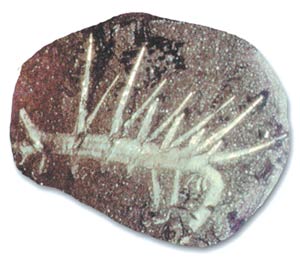 |
| A fossil discovered in Cambrian rock beds |
The question of how the world came to be suddenly filled with very different invertebrate species and how so many different species with no forerunners came into being is one that evolutionists are unable to answer.
The British biologist Richard Dawkins, one of the world’s leading proponents of the idea of evolution, has this to say on the subject—which fundamentally invalidates the theses he maintains:
For example, the Cambrian strata of rocks. . . are the oldest ones in which we find most of the major invertebrate groups. And we find many of them already in an advanced state of evolution, the very first time they appear. It is as though they were just planted there, without any evolutionary history. Needles to say, this appearance of sudden planting has delighted creationists. 65
As Dawkins admits, the Cambrian Explosion is clear evidence of creation, since that is the only explanation of how living things appeared with no evolutionary ancestors behind them. The evolutionist biologist Douglas Futuyma also admits this fact:
Organisms either appeared on the earth fully developed, or they did not. If they did not, they must have developed from preexisting species by some process of modification. If they did appear in a fully developed state, they must indeed have been created by some omnipotent intelligence. 66
If numerous species, belonging to the same genera or families, have really started into life all at once, the fact would be fatal to the theory of descent with slow modification through natural selection. 67
The Cambrian Period confirms the picture described by Darwin as a fatal. That is why the Swedish evolutionist Stefan Bengtson admits the absence of intermediate forms in discussing the Cambrian Period and says, “Baffling (and embarrassing) to Darwin, this event still dazzles us.”68
As we have seen, the fossil record shows that living things emerged suddenly and perfectly formed, and did not—as the theory of evolution maintains—follow a process from the primitive to the developed. Living things did not come into being through evolution, but were all separately created.
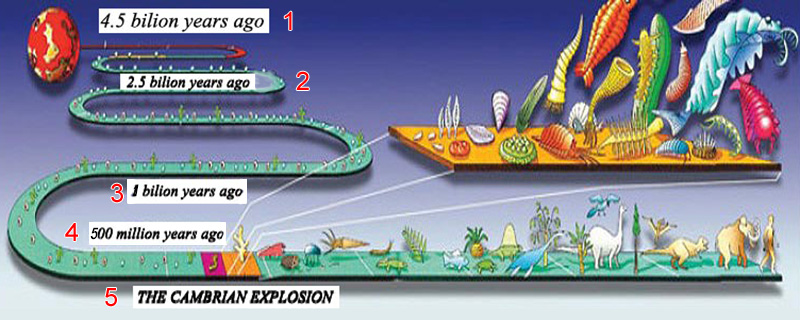 |
| 1. 4.5 billion years ago |
The Cambrian Period is a geological age that began some 520 million years ago and is estimated to have lasted 10 million years. Apart from single-celled organisms and a few simple multi-celled organisms, no traces of living things from before that period are to be found in the fossil record. But in the exceedingly short Cambrian Period (10 million years being a very brief space of time in geological terms), all the animal phyla emerged simultaneously, with not a single deficiency among them. In the geologic periods that followed. Basic classifications such as fish, insects, amphibians, reptiles and birds, and subgroups thereof, also appeared suddenly, and with no forerunners preceding them.
This totally demolished the theory of evolution’s fundamental claim, that of gradual development over a long period of time by way of chance. Moreover, this also represents major evidence for the fact of creation.
Mark Czarnecki, and evolutionist and paleontologist, in effect admits as much:
A major problem in proving the theory has been the fossil record. . . This record has never revealed traces of Darwin's hypothetical intermediate variants—instead, species appear and disappear abruptly, and this anomaly has fueled the creationist argument that each species was created by God. 69
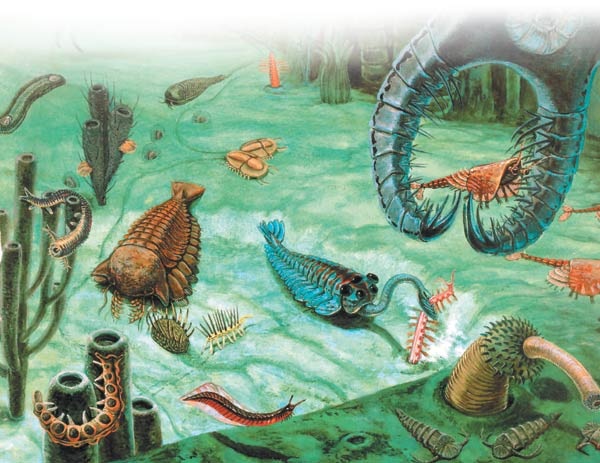 |
| Living things from the Cambrian Period |
Carbon-14 is one form of radiometric test, but one very important feature distinguishes it from the others. Other radiometric tests can be used only in determining the ages of volcanic rocks. Carbon-14 dating, however, can be used to determine the ages of once-living things. That is because Carbon-14 is the only radioactive substance found in the bodies of living organisms.
The Earth is constantly being bombarded by cosmic rays from outer space. These rays strike nitrogen-14, found in high levels in the atmosphere, and transform this into carbon-14, a radioactive substance. Radioactive carbon-14, a newly produced element, combines with oxygen in the atmosphere, forming another radioactive compound, C-14 O2. As we know, plants use CO2 (carbon dioxide), H2O (water) and solar rays in order to produce their nutrients. Some of these carbon dioxide molecules the plant absorbs into its body are molecules formed from radioactive carbon-14. The plant accumulates this radioactive substance in its tissues.
Some animals feed on plants; other living things feed on the creatures that feed on plants. Via this food chain, the radioactive carbon that plants have absorbed from the air is transferred to other living things. In this way, every living thing on Earth absorbs an equal level of carbon-14 into its body.
 |
| 1. Sunlight, 2. 6C02 Carbon dioxide, 3. 6H2O Water, 4. Chlorophyll, 5. C6H12O6 Glucose, |
| Plants use CO2 (carbon dioxide), H2O (water), and sunlight to produce food. Part of these carbon dioxide molecules absorbed into the body of the plant are molecules consisting of radioactive Carbon-14. The plant collects this radioactive substance in its tissues and, by way of the food chain, the radioactive carbon that plants absorb from the air is transferred to other living things. |
When that plant or an animal dies, it is of course no longer able to feed and absorb any more carbon-14. Since carbon-14 is a radioactive substance, it has a half-life, and gradually begins losing electron. Thus the age of a once-living thing can be calculated by measuring the amount of carbon-14 left in its tissues.
The half-life of carbon-14 is around 5,570 years. In other words, the amount of carbon-14 in the dead tissue declines by half once every 5.570 years. For example, if there were 10 grams of carbon-14 in a living thing’s body 5.570 years ago, then there will now be only 5 grams. This test, like other radiometric tests, cannot be used to determine the age of specimens which are thought to be very old, since carbon-14 has only a short half-life. Carbon-14 dating is regarded as giving accurate results for specimens between 10,000 and 60,000 years old.
Carbon-14 testing is one of the dating tests most frequently employed. Evolutionists use this method in order to determine age when examining the fossil record. However, as with other radiometric tests, there are serious doubts concerning the reliability of carbon-14 dating. The most important of these is the high likelihood of gas exchange between the specimen to be dated and the outside environment. This exchange mostly comes about by means of waters containing carbonate or bicarbonate. If these natural waters—which contain carbon-14—come into contact with the specimen, then some of the carbon-14 atoms they contain will pass into the specimen. In that event, the specimen will test younger than it really is.
The exact opposite of this situation may also arise. Under certain conditions, the amount of carbon-14 in the specimen to be dated can be released into the external environment in the form of carbonate and/or bicarbonate. In that event, the specimen will appear to be older than it actually is.
Indeed, various concrete findings have revealed that carbon-14 dating is not all that reliable. Carbon-14 dating tests on specimens whose age is known for certain have often given false results. For instance, the skin of a newly dead seal was depicted as being 1.300 years old.70 A living shell was dated as 2.300 years old.71 A deer antler was variously dated as 5.340, 9.310 and 10.320 years old.72
A piece of tree bark was dated as 1.168 and 2.200 years old.73 Carbon-14 dating gave an age of 6.000 years for the city of Jarmo in northern Iraq, where people have been living for 500 years.74
For all these reasons, carbon-14 dating, like other radiometric tests, cannot be regarded as wholly reliable.
The theory of evolution, maintaining that all living things evolved by chance from a common ancestor, makes frequent use of the concept of adaptation. Evolutionists claim that by adapting to their environments, living things develop into entirely new species. In fact, the concept of evolution through adaptation is a hangover from the primitive scientific understanding of Lamarck’s day and has long since been refuted by scientific findings. (See Adaptation)
However, despite having no scientific basis, the idea of adaptation still influences most people. When told that the Earth is a special planet for life, they immediately assume that since life emerged under the conditions on such a planet, so other forms of life could develop on other planets. Science-fiction writers imagine, for example, that while human beings live on Earth, there could be living things on the planet Pluto that perspire at -238°C degrees, that breathe helium instead of oxygen, or that drink sulphuric acid instead of water.
Yet such imaginative ideas are actually based on ignorance. Evolutionists with knowledge of biology and biochemistry do not actually support such fantasies, since they are well aware that life can exist only with specific elements and when specific conditions are established.
The adaptation error in question is also the result of such ignorance. The only model of life with any scientific validity is that of carbon-based life, and scientists have concluded that there cannot be any other physical life in the universe based on other elements.
Carbon is the sixth element in the periodic table. Its atoms are the basis of life on Earth because all basic organic molecules (such as amino acids, proteins and nucleic acids) form as the result of carbon atoms combining with certain other atoms in particular ways. Carbon forms the various types of protein in our bodies by combining with hydrogen, oxygen, nitrogen and other elements. No other element can replace carbon, because no other element has the ability to make so many unlimited types of chemical bonds.
Therefore, if there is to be life on any other planet in the universe, it will inevitably have to be carbon-based life.75
In addition, carbon-based life has a number of immutable laws. For example, carbon-based organic compounds (proteins) can only exist in a specific temperature range. Above 120 degrees Celsius, they begin to break down, and at temperatures below -20 degrees they begin to freeze. Other factors such as light, gravity, atmospheric make-up and magnetic forces must all fall within narrow and specific ranges in order to permit carbon-based life.
The Earth possesses just those narrow and specific ranges. If any one of these is exceeded—if the Earth’s surface temperature exceeds 120 degrees, for example—then life on this planet will be impossible.
Life can exist only when very special and specific conditions are met. To put it another way, living things can only exist in an environment specially created for them. The Earth is an environment specially created by our Lord, and all its details reveal God’s mercy on us.
The most important characteristic of the Carboniferous Period is the enormous variety of plant fossils belonging to it. There is no difference between fossils belonging to this period and plant species alive today. This variety, which appears suddenly in the fossil record, represents a major dilemma for evolutionists, because each of these plant species appeared suddenly on Earth, each with its own perfect systems.
 |
Evolutionists sought to avoid this dilemma by giving it a name suggestive of evolution, describing it as the “evolutionary explosion.” But of course, that description only shows that evolutionists have no explanation to offer on this subject. Plants were performing photosynthesis millions of years ago, just as they do today. Even then, they possessed hydraulic systems powerful enough to crack stone, pumps capable of raising water absorbed from the soil to many meters in height, and chemical factories producing foodstuffs for living things. This shows that plants were created millions of years ago. Their creator, God, Lord of the Worlds, continues to create them today. It is impossible for human beings seeking to understand the miracles of creation in plants, even using the most advanced means provided by present-day technology, to create a single plant from nothing—or even a single leaf.
The complex structure of the cell was unknown in Darwin’s time. For that reason, evolutionists of the day believed that it was perfectly reasonable to answer the question of “How did life emerge?” by saying “Through coincidences and natural events.” Darwin suggested that the first cell would have had no trouble forming in a small, warm drop of water. (See The Abiogenesis View, the) But the fact is that 20th-century technology, which made visible even to the tiniest microscopic details, revealed that the cell was actually the most complex structure yet encountered. Today we know that the cell contains energy-producing plants, factories that produce the enzymes and hormones essential to life, a data bank containing all the information about the products to be manufactured, a complex transportation system that carries raw materials and products from one region to another, pipelines, advanced laboratories and refineries that break down raw materials brought in from the outside, and cell-membrane proteins that regulate the entry and departure of various materials from the cell. And this is only a part of the cell’s complex structure.
 |
The evolutionist scientist W. H. Thorpe writes,
“The most elementary type of cell constitutes a 'mechanism' unimaginably more complex than any machine yet thought up, let alone constructed, by man.” 76
So complex is the cell that even today’s advanced technology cannot duplicate one. All the research aimed at making an artificial cell has ended in failure. The theory of evolution, on the other hand, maintains that this system—which man has been unable to replicate with all the knowledge and technology at his disposal—once formed by chance on the primeval Earth. This is far less likely, for instance, than even an explosion in a publishing house resulting in the coincidental printing of an encyclopedia.
The British mathematician and astronomer Sir Fred Hoyle offered a similar analogy in the 12 November 1981 edition of Nature magazine. Despite being a materialist, Hoyle stated that there was no difference between a living cell coming into being by chance and a Boeing 747 jet spontaneously assembling itself when a whirlwind hit a scrap yard. 77 In short, it is not possible for a cell to form spontaneously, as the result of coincidence.
One of the main reasons why the theory of evolution cannot explain how the cell came into being is the irreducible complexity it possesses. (See Irreducible Complexity.) A cell thrives through the its large number of organelles all working together in harmony. It cannot survive in the absence of any one of these. The cell cannot wait for such unconscious mechanisms as mutation and natural selection to develop it. Therefore, the first cell to appear on Earth must have been fully formed, together with all the organelles and biochemical functions essential for its survival.
In the human body, there are more than 100 trillion cells, some of them so small that a million of them would cover only the tip of a needle. However, biologists unanimously agree that, despite its minute size, the cell is the most complex structure that science has yet confronted. The cell, continuing to harbor a great many unresolved mysteries, represents one of the major dilemmas facing the theory of evolution. The well-known Russian evolutionist A. I. Oparin says:
Unfortunately, however, the problem of the origin of cell is perhaps the most obscure point in the whole study of the evolution of organisms. 78
The cell is the building block of any living organism. Therefore, it is impossible for a theory—which cannot even explain the emergence of the proteins and amino acids that comprise the cell—to account for the appearance of living things on Earth. On the contrary, the cell constitutes one of the clearest pieces of evidence that all organisms, including human beings, are created.
 | |
| 1. Nucleus | 8. Lysosome |
Yet evolutionists still manage that living things emerged by chance in the most uncontrolled environment possible—that existed on the primeval Earth. This claim can never agree with the scientific facts. In addition, even the simplest mathematical calculations have proven that chance cannot give rise to even one of the millions of proteins in cells, let alone to a cell in its entirety. This shows that the theory of evolution, far from being rational and logical, is a collection of scenarios based on imagination, fantasy and implication.
Despite holding evolutionist views, the zoologist David E. Green and the biochemist Prof. Robert F. Goldberger have this to say in a paper in a scientific journal:
The popular conception of primitive cells as the starting point for the origin of the species is really erroneous. There was nothing functionally primitive about such cells. They contained basically the same biochemical equipment as do their modern counterparts. How, then, did the precursor cell arise? The only unequivocal rejoinder to this question is that we do not know. 79
The perfect harmony and cooperation between cells is just as astonishing as the existence of a single cell. All the cells in a human being come into existence through the division and multiplication of a single embryonic cell. And all the information regarding the present structure of our bodies—their shape, design and all their features—is present in the chromosomes in the nucleus of that first cell, from the very beginning.
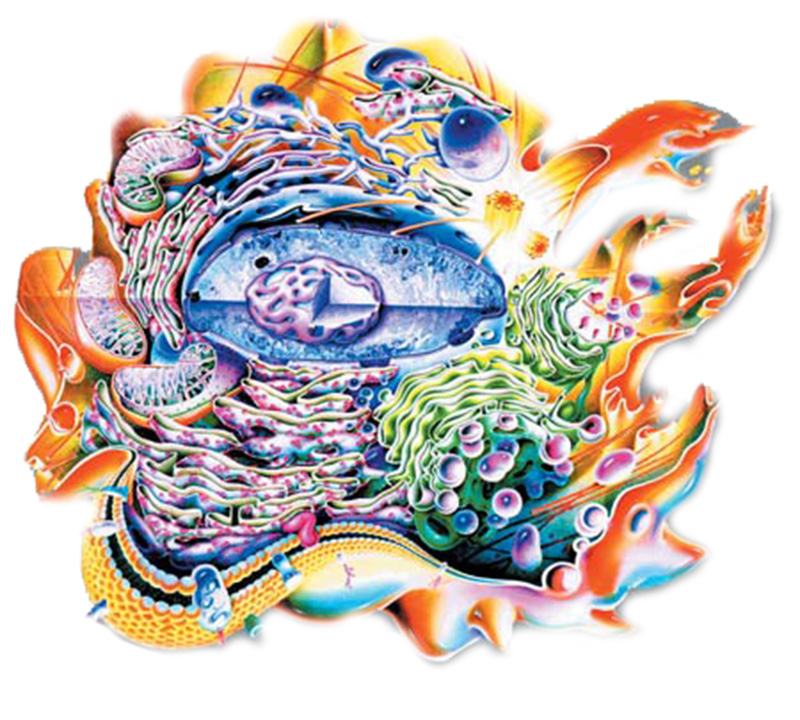 |
| In Darwin’s day, no one knew that the cell has an exceedingly complex structure and system. As technology progressed, however, it became clear that these complex structures could not possibly have formed by chance, placing evolutionists in an impossible position. |
The continuity of any human’s life depends on the harmonious functioning of the components of the cells and of those cells with one another. Even while the cell works together with other cells in great order, it also maintains its own life in a state of and a delicate equilibrium. The cell identifies and produces a great many substances, including the energy necessary for its survival and to maintain that order and equilibrium. Those of its needs it cannot meet by itself, it selects very carefully from the outside—so selectively that none of the random substances in the external environment can enter by chance without the cell’s permission to do so. There are no aimless, unnecessary molecules in the cell. Their controlled exit from the cell also takes place as the result of strict monitoring.
In addition, the cell possesses a defense system to protect it from all external threats and attack. Despite all the structures and systems it contains and the countless activities that take place in it, an average cell is not the size of a small city, but just 1/100 millimeters in diameter. Each of the cell’s functions listed above is a miracle in its own right. (See DNA.)
Evolutionists refer to all the claims regarding the synthesis of the amino acids that gave rise to life in the supposedly primitive atmospheric conditions are as chemical evolution. (See Primordial soup fantasy, the) Before they move on to scenarios about the evolution of living things, evolutionists must first account for the formation of DNA nucleotides and amino acids, the building blocks of life. According to their claims, which are based on no evidence whatsoever, simple compounds containing carbon, oxygen, nitrogen and phosphorus were dissolved in water and then exposed to a constant bombardment of ultraviolet rays and lightning, thus giving rise to different compounds. These small molecules, supposedly produced by chance, subsequently bonded chemically, thus increasingly enriching their complex combinations. Eventually, it is suggested that the water turned into a thick soup containing new forms of molecules in copious amounts. If one waits long enough, it was said, even the most unlikely reactions will take place. 80
Yet none of these hypotheses are supported by any scientific findings. Indeed, evolutionists themselves admitted that their account is actually a hypothesis which can never be proven. To suggest that these claims, which cannot be verified or duplicated even under present-day conditions, , actually came about spontaneously as the work of chance, is therefore incompatible with logic and reason. (See Primordial soup fantasy, the.)
The DNA molecule in the cell nucleus is wrapped up in special coverings known as chromosomes (See, DNA). The total length of the DNA molecule packaged in the chromosomes in a single cell reaches 1 meter (3.3 feet). The total thickness of the chromosome is 1 nanometer, or 1 billionth of a meter. The one-meter-long (3 feet, 3 inches long) DNA molecule is twisted and folded into this tiny volume.
Inside the nucleus of every human cell (except for reproduction, or germ cells) there are 46 chromosomes. If we compare every chromosomes to a book made up of pages of genes, then we can compare the cell to a six-volume encyclopedia containing all a person’s characteristics. The information in this “encyclopedia” is equivalent to that found in a 32-volume edition of the Encyclopedia Britannica.
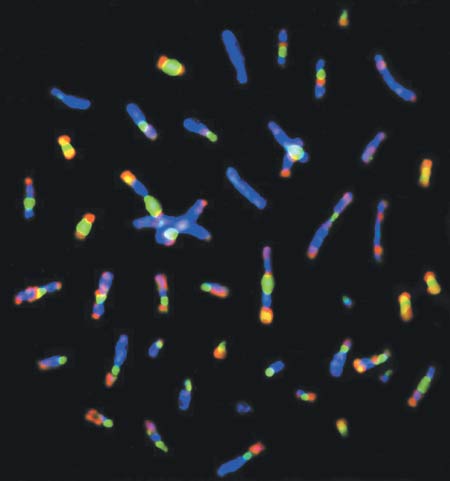 |
| DNA molecules, roughly 1 meter long, are squeezed into chromosomes just 1 billionth of a meter thick. |
The chromosomes containing the DNA molecule actually consist of much smaller special packaging systems. This DNA molecule is first tightly surrounded by special proteins known as histones, just like cotton wound round a spool. Those parts of the DNA attached to the histone spools are known as the nucleosomes, which have been designed to protect the DNA from any harm. When nucleosomes are combined end to end, they constitute chromatins, which cling tightly to one another and fold over, forming dense coils. Thus it is that the DNA molecule is able to be squeezed so perfectly into an area just 1 millionth of its actual length.
Alexander I. Oparin, a leading proponent of evolution, describes coacervates as blobs of organic matter (mostly containing sugars and short polypeptides), supposedly the precursors of modern cells.81 At one time evolutionists maintained that coacervates were the forerunners of the cell, and that proteins emerged as a result of the evolution of coacervates. However, this claim, devoid of any scientific evidence—was later abandoned as invalid by even the evolutionists themselves.
Even the simplest looking organism has energy producing and transforming mechanisms for its own survival, as well as complex genetic mechanisms to ensure the survival of the species concerned. Coacervates, however, are simple collections of molecules lacking any such systems and mechanisms. Their structures are prone to be broken down by even the slightest natural effects. It is totally unscientific to claim that they gradually and spontaneously came to life by developing such complex systems.
One evolutionist reference describes how coacervates cannot represent the basis of life:
Droplets with metabolism such as coacervate cannot of course be regarded as living. Because they lack two fundamental characteristics as inheritance and mutation. In addition, the primitive cell, in other words the protobiont, cannot be regarded as a pre-formative stage. Because the substances used in these droplets are formed from present-day organisms. 82
However, some circles who have turned evolution into an ideological slogan continue to portray coacervates as major evidence for evolution in their publications, without admitting the slightest scientific doubt on the matter. As always, their aim is to portray the theory of evolution as backed by extensive scientific evidence and to deceive those who lack detailed information about the subject about and the means to investigate it.
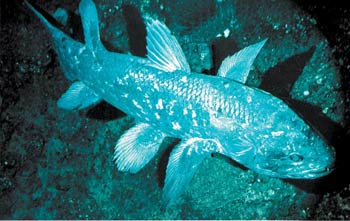 |
| After examining Coelacanth fossils, evolutionists used to say that it was an intermediate form in the transition of vertebrates from sea to dry land. However, the capture of living Coelacanth specimens, beginning in 1938, showed just how far evolutionist speculation could be carried. |
The Coelacanth is a species of fish that used to be put forward as evidence for vertebrates’ “transition from water to land” thesis. Fossil Coelacanths were once regarded as evidence of an intermediate form between fish and amphibians. Based on fossil remains of the creature, evolutionist biologists suggested it contained a primitive (and not yet fully functional) lung in its body.
This organ was described in a great many scientific sources. Drawings were even published showing the Coelacanth moving from the sea onto dry land.
On 22 December 1938, however, a most significant discovery was made in the Indian Ocean. A living member of the species Latimeria, a member of the Coelacanth species that had been portrayed as having become extinct 70 million years ago, was caught in the open sea! The discovery of a living Coelacanth definitely came as a major shock to evolutionists. The evolutionist paleontologist J. L. B. Smith said that he could not have been more astonished if he had met a dinosaur in the street.83 In the years that followed, more than 200 Coelacanths have been caught in various regions of the sea.
When the first few of these fish were examined, it was realized that the speculation concerning them had been groundless. Contrary to what had been claimed, the Coelacanth had no primitive lung or a large brain. The structure that evolutionist researchers had thought to be the fish’s a primitive lung was actually nothing more than an oil sac in its body.84 Moreover, it was also realized that the Coelacanth, which had been depicted as a amphibian-to-be preparing to emerge from the water, actually lived in deep ocean waters and hardly ever rose to above 180 meters (590 feet). 85
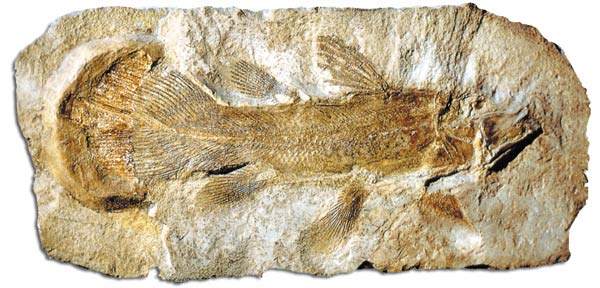 |
At this news, the popularity of the Coelacanth among evolutionist publications suddenly waned. An evolutionist paleontologist by the name of Peter L. Forey made this admission in an article in Nature magazine:
The discovery of [living specimen of] Latimeria raised hopes of gathering direct information on the transition of fish to amphibians, for there was then a long-held belief that coelacanths were close to the ancestry of tetrapods. . . .But studies of the anatomy and physiology of Latimeria have found this theory of relationship to be wanting and the living coelacanth's reputation as a missing link seems unjustified. 86
 |
| Cloning consists of the duplication of genetic information that already exists. No new mechanisms or new genetic information are added during the process. |
As his admission shows, no intermediate form between fish and amphibians ever existed. The Coelacanth, the only serious intermediate form proposed by evolutionists, is nothing more than a living species of fish with nothing whatsoever to do with evolution.
With advances in the science of genetics, the possibility of genetically duplicating living things—and therefore human beings came to the agenda as well. Such a copying process is feasible, though evolutionist scientists in particular refer to this process as “creating living things.” This most striking logic is far removed from the true facts, because “creation” means making something from nothing—and that verb belongs exclusively to God.
If genetic science can produce an identical copy of a living thing, that does not imply the creation of an organism from nothing. Because in copying a human being or any other organism, a living thing’s cells are extracted, and then induced to replicate themselves. Not one single cell can ever be brought into existence from nothing. This important distinction shows that creation belongs to God alone. (See DNA; Fox Experiment, the; and also Miller Experiment, the.)
 |
| The issue of cloning recently became an important item on the scientific agenda. Although cloning is a process that occurs according to known laws, evolutionists sought to use it to support their own theories, in the same way they do with every new scientific development. A number of media organizations that give evolution their ideological support raised the subject to the headlines with pro-evolution slogans. The subject of cloning was portrayed as if it were proof of evolution. Yet it was actually obvious that it had nothing to do with evolution at all. The scientific world did not take these ridiculous evolutionist endeavors seriously at all. |
| To the side: A scientific publication describing how cloning is carried out. A pregnant white sheep |
 |
| In the absence of a cold trap mechanism, even if some kind of amino acid were obtained, these molecules would immediately be broken down by conditions in the same environment that created them. |
When analyzed realistically, the Miller experiment—first performed to prove that life could have emerged by chance in the primitive atmosphere—can be seen to be riddled with various inconsistencies.
One factor that invalidates the Miller experiment is the mechanism known as the cold trap, a mechanism that isolates amino acids the moment they form. Otherwise, the conditions giving rise to amino acids would immediately destroy these same molecules. Yet it is absurd even to consider the possibility that any such protective arrangement came about under in primeval conditions that included ultraviolet rays, lightning, various chemicals and high levels of oxygen. In the absence of any mechanism like a cold trap, any amino acids that were obtained would be immediately broken down again.
The chemist Richard Bliss describes this contradiction:
"Cold trap", being the crucial part of Miller’s tools, has the duty to collect the products as they were formed out of chemical reactions. Actually, without this cold trap, the chemical products would be destroyed by the energy source (electrical sparking). 87
In Miller’s previous experiments, in fact, he had used the same materials, but had failed to obtain even a single amino acid without setting up a cold trap mechanism.
Miller’s aim was to obtain amino acids, and the methods and equipment he employed were specially arranged in order to achieve that objective. Above all, however, even if we postulate the existence of intelligence capable of ensuring such a method, order and arrangement in the primitive atmosphere, this conflicts with the theory of evolution’s own logic.
See Inconsequence of Panspermia hypothesis.
This interpretation was put forward by Darwin and repeated by all the evolutionists who followed him. According to this claim, living things have similar organs because they evolved from one common ancestor. For example, the fact that all vertebrate land dwellers have five digits at the end of their four limbs is the result—according to evolutionists—that they all evolved from a common forerunner, namely the first fish assumed to have survived on land.
The theory of evolution has dominated the world of science since the late 19th century, and its interpretation of similarities has also been widely accepted. Every similarity in living things is interpreted as evidence of some “ancestral” evolutionary relationship between them.
Yet findings obtained over the last 20 to 30 years show that this is not at all the case. To summarize:
1) Homologous (similar) organs are found in living things belonging to totally different classes, among which evolutionists can construct no evolutionary link.
2) The genetic codes of these animals’ similar organs are entirely different.
3) The stages of embryological development of these organs are very different.
These facts alone show that homology constitutes no evidence for evolution.
Indeed, it has been realized that living things with similar organs are so far apart from one another genetically that no evolutionary links can be found between them.
In order for Darwin’s “common ancestor” explanation to be true, these similarities in living things would have to be genetically very close to one another. Conversely, if such similarities are genetically far apart, then the possibility of any common ancestor is not tenable. On the contrary, it can be seen that the fact of creation is the true explanation. (See Common creation, below.) No evolutionary relationship can be claimed between living things that are genetically so very different from one another. (See Homology.)
Similar organs or similar molecular structures in living things provide no support for the theory that they are evolved from any common forerunner. (See Homologous organs.) On the contrary, these similarities refute the possibility of conjecturing any hierarchical evolutionary family trees among living things. If one comparison of proteins suggests that human beings are similar to chickens; and another comparison, similar to the nematode worms; in, and a third analysis to crocodiles, then it cannot be proposed that these living things evolved from one another—or from any other common ancestor.
Scientists such as Carolus Linnaeus or Richard Owen, who both first raised the subject of similar organs in living things, regarded such organs as examples of common creation. (See Linnaeus, Carolus) In other words, similar organs did not evolve by chance from any shared forerunner. Quite the contrary; they were created to perform similar functions, which is why they resemble one another.
Today’s scientific findings demonstrate that the claim of common ancestry regarding similar organs is invalid, and that the only possible explanation is common creation.
Communism, elevated to its highest point in the 19th century by the two German philosophers Karl Marx and Friedrich Engels, led to such bloodshed as to dwarf even the state massacres of the Nazis and Imperialist nations. (See Marx, Karl.) Even though communism is generally agreed to have collapsed in 1991, this dark ideology still continues to influence people, and its materialist philosophy turns them away from religion.
This ideology caused a wave of global terror in the 20th century, but actually represents a stream of thought that’s been around since ancient times. Materialism was a philosophy that regarded matter as all that exists. Communism was base in turn constructed upon that philosophy, and first made its appearance in the 19th century.
Marx and Engels, communism’s intellectual founders, sought to describe materialist philosophy in terms of a method known as Dialectics (which see) Marx maintained that the entire history of humanity was one of conflict, that ongoing struggle of his time was between workers and capitalists, and that soon the workers would rise up and organize out a communist revolution. Both dyed-in-the-wool atheists, Marx and Engels regarded the elimination of religion as essential for communism to succeed. However, the actions and struggle to be waged had to be placed on a legitimate philosophical footing.
 |
| The aim of communism is to take the theory of evolution that Darwin applied in the field of biology and apply it to human societies as well—and for human beings to be in a state of war and conflict as wild animals supposedly do in nature. |
The theory of evolution, proposed by Darwin in his book the Origin of Species, became the scientific guise their ideology had been waiting for. Darwin claimed that living things emerged and developed as the result of a “struggle for survival”, in other words, through dialectical conflict. In addition, he rejected religious beliefs by denying creation. In those terms, Darwinism provided an intellectual support for the assertions of communism.
Hostility towards religion formed the basis of the alliance between Darwinism and communism. The most important reason for the communists’ devotion to Darwinism was the support it gave to atheism. In his book Soviet Marxism and Natural History, David Jorafsky describes this relationship:
In spite of its scientific deficiencies, evolution's alleged scientific character has been used to justify all kinds of ungodly systems and practices. The most successful of these, thus far, seems to be communism, and its adherents all over the world have been deluded into thinking that communism must be true because it is based on the science of evolution.88
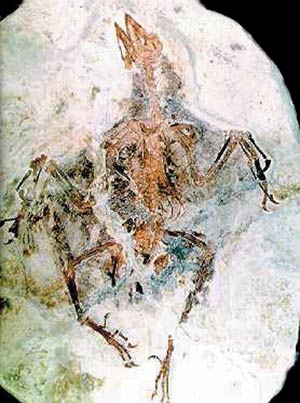 |
| Confuciusornis, which lived at around the same time as Archaeopteryx, bears a close resemblance to modern birds. |
Communism’s objective was to apply the theory of evolution, which Darwin had applied to biology, to human societies, advocating that for human beings, like wild animals, are in an inevitable state of conflict and war.
In 1995, Lianhai Hou and Zhonghe Zhou, two paleontologists from the Vertebrate Paleontology Institute in China, discovered a new fossil bird they named Confuciusornis. This winged vertebrate—the same age as Archaeopteryx, approximately 140 million years old and long considered to be the earliest ancestor of all birds and regarded as semi-reptilian. Yet Confuciusornis bore a very close similarity to birds living today. It had no teeth, and its beak and feathers have exactly the same characteristics as those of birds alive today. This bird’s skeletal structure is identical to that of today’s birds, but as with Archaeopteryx, its wings had claws.
Also apparent was a structure known as the pygostyle, which supports the tail feathers. Naturally, its presence undermined the evolutionist thesis that Archaeopteryx was the primitive ancestor of all birds. 89
Confuciusornis, so similar to modern-day birds, has conclusively disqualified Archaeopteryx, which evolutionists for decades pointed to as the prime evidence for their scenario of evolution.
This is one means by which organisms such as bacteria transmit genes between themselves. In conjugation, two bacteria from the same species come alongside one another and form a temporary cytoplasmic bridge, over which a mutual exchange of DNA takes place.90
Genetic variety in bacteria is increased by means of conjugation. However, since no separate bacterial cell emerges as a result, this mechanism cannot be regarded as sexual reproduction. (Bacterial reproduction by way of mutual contact is known as sexual reproduction with conjugation.)
Evolutionists, however, do regard these newly emerging genetic variations as a universal feature of sexual reproduction.91 Since the initial bacteria have different characteristics from those that emerge subsequently, evolutionists take this as evidence for evolution. In fact, what is happening here is actually variation. The genes from the two bacteria do give rise to further variety, but no new genes or genetic data are added to the genetic pool. As a result, the bacteria remain the same species of bacteria, and no new subspecies emerges.
The question of the origin of life—of how the first living things came into existence on Earth—was one of the greatest dilemmas confronting materialism for the last 150 years. That is because the cell, once regarded as the simplest component of any organism, actually possesses a complexity incomparably greater that any technology produced by humans. Probability calculations prove that not even proteins, the building blocks of the cell, could ever have come into being by chance. This, of course, is proof of creation.
One such calculation was performed by Robert Shapiro, a professor of chemistry and DNA expert from the University of New York. An evolutionist, Shapiro calculated the probability of the 2.000 varieties of protein in a simple bacterium having emerged by chance. (There are some 200.000 varieties of protein in the human body.) The result he obtained was 1 in 10/40.000.92 This figure, 1 followed by 40.000 zeroes, has no equivalent in the entire universe.
The fact revealed by this figure is that materialism, and Darwinism, its counterpart in the natural sciences—both of which seek to account for life in terms of chance, are equally invalid. Chandra Wickramasinghe, Professor of Applied Mathematics and Astronomy at Cardiff University, says this about Shapiro’s calculations:
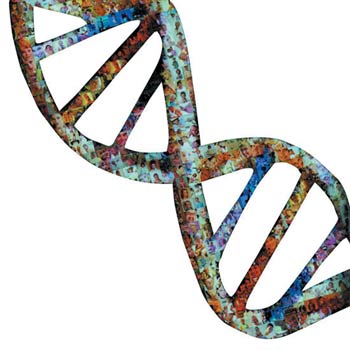 |
| Francis Crick's discovery of DNA shed light on its extraordinarily complex structure. |
The likelihood of the spontaneous formation of life from inanimate matter is one to a number with 40,000 noughts after it. . . . It is big enough to bury Darwin and the whole theory of evolution. There was no primeval soup, neither on this planet nor on any other, and if the beginnings of life were not random, they must therefore have been the product of purposeful intelligence. 93
On the same subject, the famous astronomer Sir Fred Hoyle made this comment:
. . . such a theory [that life was assembled by an intelligence] is so obvious that one wonders why it is not widely accepted as being self-evident. The reasons are psychological rather than scientific. 94
Both Hoyle and Wickramasinghe are people that have long engaged in science and adopted materialism. Yet the truth that confronted each of them is that life was created, and they have been forced to admit it. Today, a great many biologists and biochemists have also abandoned the myth that life was born as a result of chance.
The fact of creation conflicts with no scientific facts. On the contrary, all scientific findings tend to support it. The Big Bang Theory, for instance, confirms that the universe had a beginning, confirming creation while refuting materialism. In the fossil record, living species appear suddenly and in their present forms with no trace of any forerunners behind them. Not a single intermediate-form fossil has ever been found of the kind that evolutionists hypothesize must have existed.
This proves the fact of creation while refuting evolution, revealing that the exceedingly complex structure of life cannot be the work of coincidences; and that intelligence, consciousness, knowledge and ability are all essential for life to emerge. This demolishes the theory of evolution while revealing proof of the existence of God. However, the adherents of evolution ignore the scientific facts and produce a dogma in the defense of their theory.
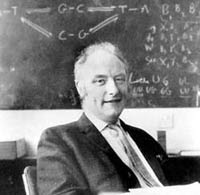 |
| Francis Crick |
Advances in genetic science and the discovery of nucleic acids—DNA and RNA, in other words—posed new problems for the theory of evolution, which seeks to account for the origin of life in terms of chance and which was already unable to offer any consistent explanation for the cell’s most basic molecules. In 1955, two scientists, James Watson and Francis Crick, revealed the unbelievably complex structure and design in the DNA molecule.(See DNA.)
DNA is found in the nucleus of each of the 100 trillion cells in the body, containing the flawless blueprint for the human body.
Francis Crick had spent years defending the theory of molecular evolution. But after his discovery of DNA, even he admitted that it was impossible for such a complex molecules to come into being by chance, spontaneously, as the result of a process of evolution:
An honest man, armed with all the knowledge available to us now, could only state that, in some sense, the origin of life appears at the moment to be almost a miracle. 95
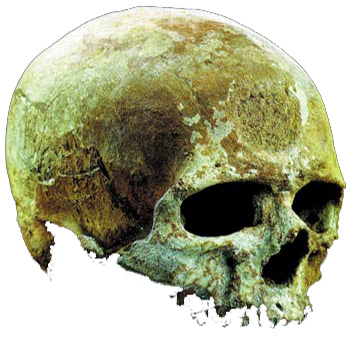 |
| A Cro-Magnon skull |
The Cro-Magnon classification was given to a European race of humans estimated to have lived around 30,000 years ago. They had a dome-shaped skull and a broad forehead. Their skull volume of 1,600-cubic centimeters is actually greater than the average skull volume of modern humans. On account of the thick eyebrow protrusions on its skull and another bony protrusion on the back of the head, Cro-Magnon Man was proposed as an intermediate form.
However, the volume and structure of the Cro-Magnon skull are very similar to those of certain human races living today in Africa and in tropical climes. Based on this resemblance, Cro-Magnon is estimated to be an ancient race that originated in Africa. Certain other paleontological findings show that Cro-Magnon and Neanderthal men interbred and formed the basis of certain races alive today. In addition, it is agreed that ethnic groups resembling Cro-Magnon Man are still alive today in various regions of Africa and in the Salute and Dordogne regions of France. Humans with the same characteristics have also been encountered in Poland and Hungary.
All this goes to show that Cro-Magnon man is not, claim, the evolutionary ancestor of human beings living today, as evolutionists suppose. The differences between the fossils and modern Europeans are no greater than that between an Eskimo and an African or between a pigmy and a European. In conclusion, Cro-Magnons represent a distinct human race that either became extinct or was assimilated by interbreeding with other races.
This is the term for the exchange of genes during cell division among similar (homologous) chromosomes from the mother and father. Homologous chromosomes make non-sibling chromatids spiral. Gene exchange takes place where the two chromosomes touch one another. Crossing-over leads to a change in the chromosome gene sequence. Thanks to this phenomenon, genetic variations arise in living things, which in turn lead to intra-species variation. However, there is no question of one species changing into another.
Crossing-over makes for variation within a given species. Exchange of single or paired components takes place between similar chromosomes during crossing-over. Since this will give the chromosomes new combinations of genes, offspring can possibly display characteristics that do not exist in either of their parents.
This is an example of a typical variation. Genes already present in the mother and father are brought together, and new combinations formed. But contrary to what evolutionists would have us believe, there can be no question, of a new species emerging. Therefore, the examples of variation proposed by evolutionists actually constitute no evidence at all for evolution. (See Invalidity of Micro-evolution the; Macro-evolution Myth, the.) The biologist Edward S. Deevey Jr. describes how crossing-over takes place within specific genetic bounds:
Some remarkable things have been done by cross-breeding . . . but wheat is still wheat, and not, for instance, grapefruit. We can no more grow wings on pigs than hens can make cylindrical eggs. A more contemporary example is the average increase in male height that has occurred the past century. Through better health care, males have reached a record adult height during the last century, but the increase is rapidly disappearing, indicating that we have reached our limit. 96
In short, such research into plants and animals merely gives rise to certain changes within the genetic information of a species. No new genetic information is ever added. No matter how much you interbreed different types of dogs, cows or horses, the result will still be dogs, cows or horses. No new species will emerge.
The theory of evolution hypothesizes that quadrupeds (four-footed life forms) evolved from fish. But in fact, this claim is inconsistent, both physiologically and anatomically, and has no basis in the fossil record. If water-dwelling creatures acquired characteristics appropriate to dry land, which evolutionists supposed happened by chance, it would give no advantage to these marine animals. There is thus no logical basis for suggesting that legs came about by way of natural selection.
| The Difference Between Fins And Feet |
 |
| 1.Coeoelacanth |
| These fishes’ bony fins are the main reason why evolutionists imagined that the Coelacanth and similar fish are the ancestors of terrestrial animals. They assumed that these bones slowly turned into feet. However, there is a fundamental difference between the bones of these fish and the feet of such land animals as Ichthyostega. As shown in Diagram 1, the bones in the Coelacanth are not connected to its backbone. The bones in Ichthyostega, however, as shown in Diagram 2, are directly attached to the backbone. Therefore, the claim that these fins slowly turned into feet is totally groundless. Furthermore, as can be seen from Diagrams 3 and 4, the structure of the bones in the Coelacanth fin and in the feet of Ichthyostega is completely different. |
On the contrary, any living thing undergoing “pre-adaptation” should be eliminated by way of natural selection, because the more characteristics it develops that are appropriate to dry land, the more disadvantaged it will be in water. In short, the scenario of transition from sea to land is totally self-contradictory. Evolutionist biologists have no consistent fossil records they can point to on this matter.
Evolutionists generally regard fish belonging to the class Rhipidistian or Cœlacanth as the ancestors of quadrupeds. These fish belong to the group Crossopterygian. Their only features that inspire hope in evolutionists are their fins, being fleshier than those of other fish. However, these fish are not intermediate forms at all, and between them and amphibians there exist enormous fundamental anatomical and physiological differences. Despite all the research that has been conducted, not a single fossil has ever been found to fill this gap. 97(See Transition from water to land thesis, the.)
Paralleling their hypothesized biological evolution, evolutionists also suggest that mankind has undergone a cultural progression from the primitive to the more advanced. They relate a great many narratives of no scientific validity in line with human evolution, which consists of no more than an imaginary family tree, and conjectures about the lives of people in the Paleolithic, Mesolithic and Neolithic ages.
The idea of human evolution is totally fictional: In order for such a family tree to exist, apes must have gradually evolved into human beings, and the relevant fossils should have been found. But in fact, there is a clear gulf between apes and man. Features such as their skeletal structures, skull sizes, and walking on two legs or four, clearly distinguish apes from human beings. It is now recognized that the supposedly intermediate forms between ape and man proposed by evolutionists (Australopithecus, Homo habilis, H. erectus, etc.) are simply biased interpretations, distortions and outright fraud. (See Piltdown Man Fraud, the; Nebraska Man Fraud, the and Neanderthal: A Human Race.)
For example, the Neanderthals (Homo neandertalis), which evolutionists suggest were a transitional species between apes and human beings, were actually human, as their genus name implies. They emerged suddenly in Europe 100,000 years ago, and disappeared, quickly and silently, some 35,000 years ago, or else were assimilated into other human races. The only difference between them and modern human beings is that their skeletons were rather more massive and their average skull volumes were slightly larger.
Today, almost everyone agrees that the Neanderthals were a human race. For a long time, some evolutionist paleoanthropologists regarded these human beings as a primitive species, although scientific findings have shown that Neanderthal Man was no different from the stockier humans who can be seen walking the streets today.
The University of New Mexico paleoanthropologist Erik Trinkhaus, regarded as an eminent authority on the subject, writes:
Detailed comparisons of Neanderthal skeletal remains with those of modern humans have shown that there is nothing in Neanderthal anatomy that conclusively indicates locomotor, manipulative, intellectual, or linguistic abilities inferior to those of modern humans. 98
Nonetheless, evolutionists still describe Neanderthals as a subspecies of modern man, suggesting that they possessed a more primitive cultural level.
Fossil findings, however, show that contrary to what evolutionists claim, Neanderthal Man actually had an advanced culture. One of the most interesting examples of this is a fossilized whistle made by Neanderthals from the thigh bone of a bear, and found in a cave in northern Yugoslavia in July 1995 by the archaeologist Ivan Turk.
Later on, the musicologist Bob Fink analyzed this whistle, whose age of which is thought to be between 43,000 and 67,000 years according to carbon-14 dating results. He determined that this instrument produced four different notes, with both full and semi-tones.
This discovery shows that Neanderthals used the seven-note scale, which now represents the basis of Western music. Fink stated that the distance between the first and third holes was twice that between the third and fourth. “These three notes . . . are inescapably diatonic and will sound like a near-perfect fit within any kind of standard diatonic scale,”99 wrote Fink, adding that Neanderthals had a musical ear and musical knowledge.
Other fossil findings show that the Neanderthals buried their dead, cared for the sick, and wore necklaces and similar adornments. 100
During the course of excavations, a 26,000-year-old needle made out of bone by Neanderthal Man was discovered. This needle, is exceedingly straight and has a hole for a thread to be passed through.101 People who possess clothing of such a kind as to require sewing needles cannot, of course, be regarded as primitive.
Steven L. Kuhn, a professor of anthropology and archaeology at University of New Mexico, and Mary C. Stiner—despite being proponents of evolution—said that their research and analysis revealed that Neanderthals who lived thousands of years ago in caves on the southeast coast of Italy engaged in activities requiring complex thought like that of modern human beings. 102
Margaret Conkey of the University of California describes how implements belonging to periods before the Neanderthals were made by conscious, intelligent communities:
If you look at the things archaic humans made with their hands, Levallois cores and so on, that's not a bumbling kind of thing. They had an appreciation of the material they were working with, an understanding of their world.103
All this proves that the cultural “evolution” proposed by evolutionists is utterly groundless.
This is one of the two main explanations proposed by evolutionists as to how terrestrial reptiles began to fly. According to this theory, reptiles took to the air vertically, by hopping from the ground. The basic concept is that certain reptiles flapped their forearms very rapidly and for long periods as they chased insects, and that over the course of time, these forelegs developed into wings. Not the slightest explanation is offered, however, for how such a complex structure as a wing could have come into existence from forearms being beaten against one another in order to trap flies.
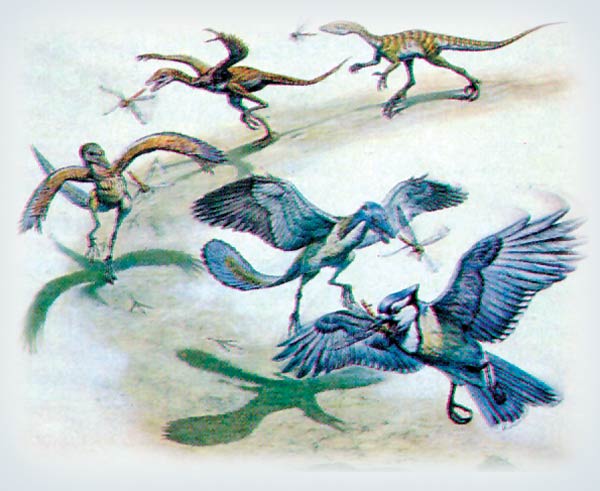 |
| The idea that dinosaurs turned into birds by growing wings as they hunted flies is not a comic story, but in fact, evolutionist theoreticians’ most serious thesis regarding the origin of birds. |
John Ostrom, a prominent adherent of the cursorial theory, admits that the proponents of both hypotheses can do no more than speculate: “My cursorial predator theory is in fact speculative. But the arboreal theory is also similarly speculative.” 104 (See Arboreal Theory, the.)
Even if we assume that mutations did cause undirected changes in a reptile’s forearms, it is still irrational to expect that any wing could emerge by chance through the addition of cumulative mutations. Any incremental mutation taking place in its forearms would not endow the reptile with functional wings, but would leave it deprived of functioning forearms. This would leave the animal disadvantaged (in other words, defective) compared to other members of its species. According to the rules of the theory of evolution, that deformed creature would be eliminated through natural selection.
Furthermore, according to biophysical research, mutations take place only very rarely. Therefore, it is impossible for these deformed creatures to wait millions of years for their deficient, incomplete wings to be completed through minute mutations.
 |
| Georges Cuvier |
The French scientist Georges Cuvier (1769-1832), now regarded as the founder of paleontology, was at the same time a geologist and comparative anatomist. He conducted wide-ranging research into the zoology and paleontology of vertebrates and invertebrates and wrote about the history of science. At the same time, Cuvier definitively revealed that some organisms that had existed in the past had become extinct and accounted for this in a way diametrically opposed to the theory of evolution. 105
Moreover, Cuvier grouped relevant classes into phyla and thus broadened Linnaeus’s classification. (See Linnaeus, Carolus.) He also applied this system to fossils and thus identified the remains of extinct life forms. Since Cuvier believed that animals possessed certain fixed and natural characteristics, he thus opposed both the theory of evolution and Lamarck’s theory that
“species could pass on to their offspring characteristics that they had acquired during their lives.” 106
Professor Ali Demirsoy, a leading proponent of evolution in Turkey, has this to say about cytochrome-C, one of the proteins which must be present in the body and which is essential for respiration, and the chances of its coming into being by chance: “as low as those of a monkey sitting at a typewriter and writing the history of mankind.” 107
Yet it is extremely interesting that Professor Demirsoy, an evolutionist scientist, should admit the impossibility of this:
The probability of forming a cytochrome-C string is so low as to be zero. In other words, we may say that if life requires a specific sequence there is a very low probability of this occurring once in the whole universe. Or else supernatural forces that we cannot define played a role in this formation. It is incompatible with science to admit the latter possibility, which means we need to investigate the first hypothesis.108
Many evolutionists prefer the impossibility in the above example over accepting supernatural forces—in other words, creation by God.
64.Richard Monastersky, “Mysteries of the Orient,” Discover, April 1993, p. 40. 
65.Richard Dawkins, The Blind Watchmaker, p. 229. 
66.Douglas J. Futuyma, Science on Trial, p. 197. 
67.Charles Darwin, The Origin of Species: A Facsimile of the First Edition, Harvard University Press, 1964, p. 302. 
68.Stefan Bengtson, “The Solution to a Jigsaw Puzzle” Nature, Vol. 345, 1990, p. 765. 
69.Mark Czarnecki, “The Revival of the Creationist Crusade,” MacLean’s, January 19, 1981, p. 56. 
70.W. Dort, Antarctic Journal of the US, 1971, p. 210. 
71.M. S. Kieth, G. M. Anderson, “Radiocarbon Dating: Fictitious Results with Mollusk Shells,” Science, August 16, 1963, p. 634. 
72.G. W. Barendsen, E. S. Deevey, L. J. Gralenski, “Yale Natural Radiocarbon Measurements,” Science, Vol. 126, p. 911. 
73.H. R. Crane, “University of Michigan Radiocarbon Dates I,” Science, Vol. 124, p. 666, specimen M-19. 
74.Charles Reed, “Animal Domestication in the Prehistoric Near East,” Science, Vol. 130, p. 1630. 
75.Michael Denton, Nature's Destiny, p. 106. 
76.W. R. Bird, The Origin of Species Revisited, pp. 298-299. 
77.“Hoyle on Evolution,” Nature, Vol. 294, November 12, 1981, p. 105. 
78.A. I. Oparin, Origin of Life, p. 196. 
79.David E. Green, Robert F. Goldberger, Molecular Insights into the Living Process, Academic Press, New York, 1967, s. 403. 
80.Mahlon B. Hoagland, Hayat›n Kökeni (“The Roots of Life”), Ankara: Tubitak, 1998, p. 40. 
81.www.encyclopedia.com/doc/1G1- 55683967.html. 
82.M. Y›lmaz Öner, Canl›lar›n Diyalekti¤i ve Yeni Evrim Teorisi, Belge Publishing, 2000, p. 165. 
83.Jean-Jacques Hublin, The Hamlyn Ency-clopaedia of Prehistoric Animals, New York : The Hamlyn Publishing Group Ltd., 1984, p. 120. 
84.Jacques Millot, “The Coelacanth,” Scientific American, December 1955, No. 193, p. 39. 
85.h t t p : / / w w w. c n n . c o m / T E C H / s c i e n - ce/9809/23/living.fossil/index.html. 
86.Peter L. Forey, “Golden jubilee for the coelacanth Latimeria chalumnae,” Nature, Vol. 336, 1988. p. 729. 
87.Richard B. Bliss and Gray A. Parker, Origin of Life, California, 1979, p. 14. 
88.David Jorafsky, Soviet Marxism and Natural Science, New York: Columbia University Press, 1961, p. 4. 
89.Pat Shipman, “Birds Do It . . . Did Dinosaurs?,” New Scientist, p. 31. 
90.Ozer Bulut, Davut Sagdic, Elim Korkmaz, Lise Biyoloji 3 (“High School Biology 3”), p. 135. 
91.Musa Ozet, Osman Arpaci, Ali Uslu, Biology 1, Istanbul: Surat Publishing, 1998, p. 138. 
92.Robert Shapiro, Origins: A Sceptics Guide to the Creation of Life on Earth, New York: Summit Books, 1986, p. 127. 
93.Fred Hoyle, Chandra Wickramasinghe, Evolution from Space, New York: Simon & Schuster, 1984, p. 148. 
95.Francis Crick, Life Itself: Its Origin and Nature, New York: Simon & Schuster, 1981, p. 88. 
96.Edward S. Deevey, Jr. 1967, “The Reply: Letter from Birnam Wood,” Yale Review, 61, pp. 631-640. 
97.Maria Genevieve Lavanant, Bilim ve Teknik magazine, April 1984, No. 197, p. 22. 
98.Erik Trinkaus, “Hard Times Among the Neanderthals.”, Natural History, Vol. 87, December 1978, p. 10. 
99.“Neandertals Lived Harmoniously,” The AAAS Science News Service, 3 April 1997. 
100.Ralph Solecki, Shanidar: The First Flower People, New York: Knopf, 1971, p. 196. 
101.D. Johanson, B. Edgar, From Lucy to Language, pp. 99, 107. 
102.Mary C. Stiner, Steven L. Kuhn, “Subsistence, Technology, and Adaptive Variation in Middle Paleolithic Italy.” American Anthropologist, Vol. 94, No. 2, 1992, pp.309-310. 
103.Roger Lewin, The Origin of Modern Humans, New York: Scientific American Library, , 1993, p. 131. 
104.John Ostrom, “Bird Flight: How Did It Begin?.” American Scientist, p. 47. 
105.http://www.strangescience.net/cuvier.htm. 
107.Prof. Dr. Ali Demirsoy, Kal›t›m ve Evrim (“Heredity and Evolution”), Ankara: Meteksan Publishing, 1995, p. 61. 